
OER Text MaterialsSociology and the Sociological Perspective, Section 1.2 (Understanding Society)Explain the debunking motif.Define the sociological imagination.Explain what is meant by the blaming-the-victim ideology.

OER Text MaterialsSociology and the Sociological Perspective, Section 1.2 (Understanding Society)Explain the debunking motif.Define the sociological imagination.Explain what is meant by the blaming-the-victim ideology.

OER Text MaterialsSociology and the Sociological Perspective, Section 1.3 (Theoretical Perspectives within Sociology)Distinguish macro approaches in sociology from micro approaches.Summarize the most important beliefs and assumptions of functionalism and conflict theory.Summarize the most important beliefs and assumptions of symbolic interactionism and exchange theory.


OER Text materialOpen Stx Chapter 12 section 2Chapter 11 in Sociology: Understanding the Changing Social World does not include an application of the three major sociological perspectives to issues of gender and sexuality. Open stax Chapter 12 section 2 does a much better job explaining gender from the major sociological perspectives including feminism. In this section there is also a discussion of doing gender, which was lacking in our core text.Sociological Perspectives on Gender StratificationHere is another source that provides a good overview of the sociological perspectives on gender.
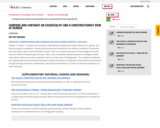
OER Text materialSociology: Understanding and Changing the Social World Chapter 11 Section 1Chapter 11 Section 1 compares sex and gender, differentiates biological and cultural influences on gender, and discusses gender socialization. Primary and secondary sex characteristics are defined. A definition of femininity and masculinity is given, but this definition is weak. There is an excellent discussion of how biology and society influence difference between girls and boys. There is also a somewhat detailed description of Margaret Mead’s work and the influence of culture on gender. There is no discussion of doing gender. This a significant weakness and supplemental material should be included to capture the notion of how gender is performed and maintained through everyday interactions. Additionally, masculinity and femininity as a continuum should be explored or at least mentioned.
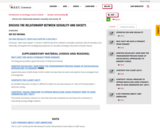
OER Text materialSex and Sexuality: Open Stax Chapter 12 Section 3Summary: Open Stax chapter 12 section 3 defines key terms related to sexuality, examines view of sexuality cross-nationally, and applies the sociological perspectives to sexuality including a discussion of queer theory.
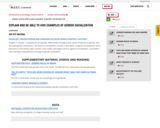
OER Text materialSociology: Understanding and Changing the Social World Chapter 11 Section 1Chapter 11 Section 1 compares sex and gender, differentiates biological and cultural influences on gender, and discusses gender socialization. The section on socialization includes a description of agents of socialization and a discussion of how family, peers, schools, mass media, and religion serve as agents of socialization. It provides a clear and fairly comprehensive coverage of gender socialization.
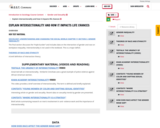
OER Text materialSociology: Understanding and Changing the Social World Chapter 11 Section 3, Gender InequalityThe final section discusses the “triple burden” and includes data on the intersection of gender and race on workplace inequality. Intersectionality is not used in this textbook. This is a major deficit.Theories of Race and EthnicityA brief definition of intersection theory.
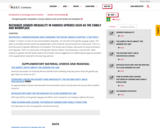
Sociology: Understanding and Changing the Social World Chapter 11 Section 3Chapter 11 section 3 covers income and workplace inequality. An overview of the gender pay gap is given. The data is a bit dated and will need to be updated with current material. Sexual harassment is discussed. There is a brief discussion of gender differences in housework. This section also includes a discussion of sexual orientation and inequality. There is no discussion of the gender division of labor, the double day or second shift. More material on gender and the family needs to be included. Several suggestions for addressing this gap are provided in the supplemental material for this learning outcome.

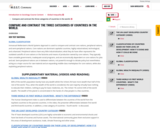
OER Text MaterialGlobal ClassificationImmanuel Wellerstein’s World Systems Approach is used to compare and contrast core nations, peripheral nations, and semi-peripheral nations. Core nations are dominant capitalist countries, highly industrialized, technological, and urbanized. Peripheral nations have very little industrialization; what they do have often represents the outdated castoffs of core nations or the factories and means of production owned by core nations. They typically have unstable governments, inadequate social programs, and are economically dependent on core nations for jobs and aid. Semi-peripheral nations are in-between nations, not powerful enough to dictate policy but nevertheless acting as a major source for raw material and an expanding middle-class marketplace for core nations, while also exploiting peripheral nations.
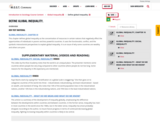
OER Text MaterialGlobal Inequality, Chapter 10This chapter defines global inequality as the concentration of resources in certain nations that negatively affect the opportunities of individuals in poorer and less powerful countries. It uses the functionalist, conflict, and the symbolic interactionist perspectives to explain global inequality. It is an issue of why some countries are wealthy and others are poor.
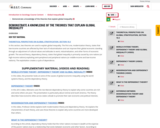
OER Text MaterialTheoretical Perspectives on Global Stratification, Section 10.3In this section, two theories are used to explain global inequality. The first one, modernization theory, states that low-income countries are affected by their lack of industrialization and can improve their global economic standing through an adjustment of cultural values and attitudes to work, industrialization, and other forms of economic growth. The second theory, dependency theory, states that global inequality is primarily caused by core nations (or high-income nations) exploiting semi-peripheral and peripheral nations (or middle-income and low-income nations). The exploitation creates a cycle of dependence.
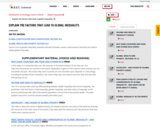
OER Text MaterialGlobal Stratification and Classification, Section 10.2 Global Wealth and Poverty, Section 10.2Factors such as gender inequality, prejudice and discrimination, sexism, and economic hierarchy are used to explain global inequality.
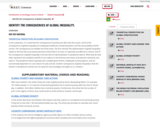
OER Text MaterialTheoretical Perspectives on Global StratificationIn this subsection, it is noted that the consequences of poverty are often also the causes. Some of the consequences of global inequality are inadequate healthcare, limited education, and the inaccessibility of birth control. The consequences are divided into three areas. The first, termed “the sedimentation of global inequality,” relates to the fact that once poverty becomes entrenched in an area, it is typically very difficult to reverse. One of the consequences of global inequality is the low level of industrialization in peripheral nations. What they do have often represents the outdated castoffs of core nations or the factories and means of production owned by core nations. The peripheral nations typically have unstable governments, inadequate social programs, and are economically dependent on core nations for jobs and aid. Another consequence of global inequality is that the workers in peripheral countries do not enjoy the same privileges and rights as U.S. workers.

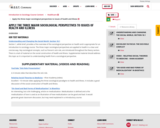
OER Text Materials Understanding and Changing the Social World, Section 18.1Section 1, while brief, provides a fine overview of the sociological perspective on health and is appropriate for an introduction to sociology course. The three major sociological perspectives are applied to health in a clear and concise way. Key sociological concepts, such as Parson’s sick role, are introduced throughout the theory section. There is a lack of material on the social construction of health and illness. Supplemental material should address this topic as it is important to understanding health from a sociological perspective.
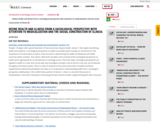
OER Text Materials Sociology: Understanding and Changing the Social World, Section: 18.1Chapter 18 begins with a great illustration of how social class impacts health. Section 1 then begins by defining health and medicine. A sociological perspective on health is provided, which includes an introduction to the importance of social location as well as social structure in determining the health of individuals and health outcomes within societies. This section, while brief, provides a fine overview of the sociological perspective on health and is appropriate for an introduction to sociology course. The three major sociological perspectives are applied to health in a clear and concise way. Key sociological concepts, such as Parson’s sick role, are introduced throughout the theory section. There is a lack of material on the social construction of health and illness. Supplemental material should address this topic as it is important to understanding health from a sociological perspective. Additionally, in the conflict theory portion of section 1, there is a very brief discussion of medicalization. Instructors interested in discussing this topic should consider supplementing with other resources.
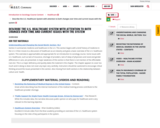
OER Text MaterialsUnderstanding and Changing the Social World, Section: 18.4Section 4 summarizes medicine and healthcare in the U.S. This section begins with a brief history of medicine in the U.S. It then moves to a discussion of healthcare as an industry and gives a basic overview of the U.S. healthcare system. This overview is approachable and appropriate for an introduction to sociology course. Some issues with U.S. healthcare, such as lack of insurance, shortage of providers, lack of sleep of physicians and racial and gender differences in care, are presented. A major weakness of this section is that there is not mention of the Affordable Care Act. This is a major deficiency and quickly dates the material in the chapter. The chapter appears to cover too much and in doing so does not cover any topic very carefully. Instructors should be cautioned to encourage critical thinking around the issues presented in this section. Also missing from both sections is the relationship between culture and health.
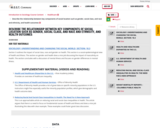
OER Text MaterialsSociology: Understanding and Changing the Social World, Section: 18.3Section 3 outlines the impact of social class, race and gender on health. This section is a social epidemiological view of health and illness. The section on gender and health does a nice job discussing the impact of masculinity on health. The section concludes with a discussion of mental illness and focuses on gender differences in mental illness.